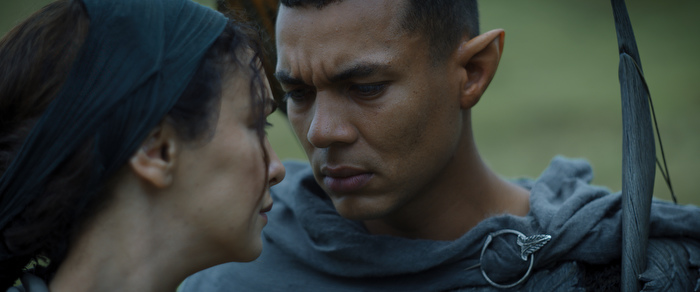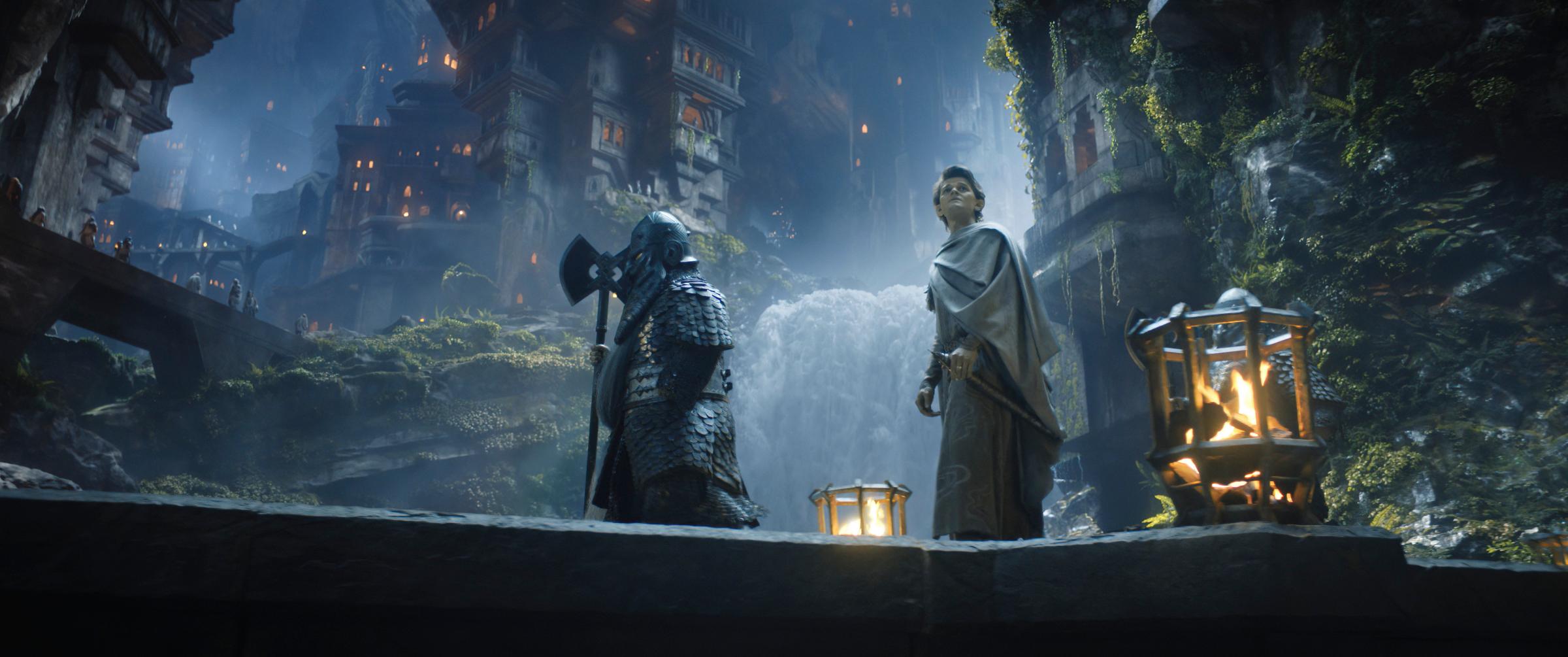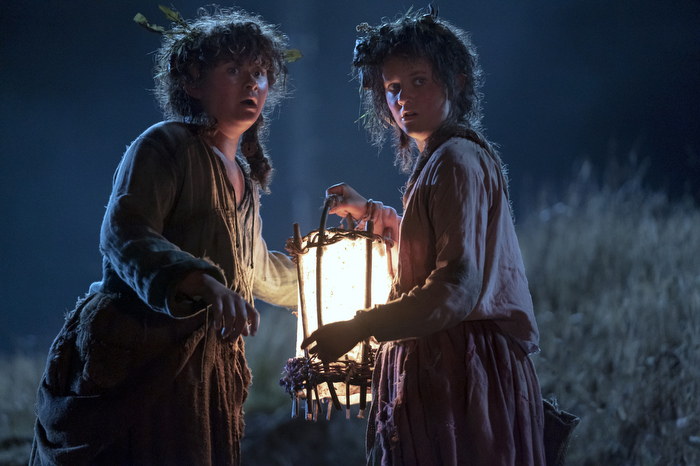In the beginning, there is Galadriel. How could it be any other way? As the black screen that accompanies The Rings of Power‘s opening seconds gives way to a beatific scene of elf children in white tunics frolicking through golden fields, she narrates the cosmic origin story of a time before evil. At the edge of a creek, a tiny, flaxen-haired Galadriel launches a sort of origami swan boat whose wings unfold into sails when the wind hits them. It’s wondrous—until the other kids sink it with stones. Later, Galadriel’s beloved older brother Finrod consoles her, crafting an allegory around the plummeting stones and the miniature ship, “whose gaze is not downward but up, fixed upon the light that guides her, whispering of grander things than darkness ever knew.”
And so, within the first few minutes of episode 1, the central metaphor of The Lord of the Rings: The Rings of Power is set. It’s not an especially imaginative one; beyond its central role in J.R.R. Tolkien’s Middle-earth lore, the binary of righteous light battling it out against evil darkness permeates Western storytelling from the Judeo-Christian Bible to Star Wars. In that sense, the choice of metaphor reflects the approach that Amazon and first-time creators J.D. Payne and Patrick McKay have taken to the most costly TV show of all time, premiering Sept. 1 in the U.S. and Sept. 2 in Europe, Asia, and the Antipodes. Instead of reinventing Tolkien’s lore, they reinscribe it in a story that reverently and expensively draws on ones viewers will have heard many times before. The end result could be timeless or tired. But in its earliest episodes, Rings of Power tantalizes without challenging.

As far as I can tell (because Amazon’s extensive security measures included placing huge, opaque watermarks on screener videos), the show looks magnificent. A record-smashing $1 billion budget has enabled it to literally light up the screen. So much adult-oriented fantasy TV—not just the Game of Thrones franchise, but also The Witcher, The Walking Dead, and Amazon’s own Carnival Row, among others—plays out against murky backdrops that set a foreboding mood and hide shoddy CGI. Rings of Power might be hurtling toward a future where humans, given the opportunity to destroy a ring whose very existence keeps evil alive in Middle-earth, instead fall prey to its allure. But like the rest of the Tolkien canon, it has a more upbeat, all-ages vibe, and so the production design establishes a tone more wonderstruck than gloomy. The elven realms seem to exist in an eternal golden hour, while mortals dwell amid rolling green hills, snow-capped mountain ranges, and frothy white waterfalls. Even the vast, underground dwarf kingdom of Khazad-dûm is illuminated by flaming lanterns and emerald foliage.
These vividly realized environments will host the climactic events of Middle-earth’s Second Age, an era that is sketched out in Tolkien’s Return of the King appendices and that led up to the forging of the rings that would play such a crucial role in a Third Age chronicled in The Hobbit and LOTR. The immortality of elves allows Payne and McKay to bring back a few familiar faces. There’s Galadriel (Morfydd Clark), of course. A serene, ethereal presence played by Cate Blanchett in Peter Jackson’s LOTR films, the character is, here, a sword-wielding commander who took up her brother’s crusade against evil after he perished at the hands of the supremely wicked Sauron (a physical forerunner to the movies’ fiery eye in the sky). After a long period of peace, the elves—led by High King Gil-galad (Benjamin Walker) and his deputy, a young statesman named Elrond (Robert Aramayo)—are behaving as though all evil in Middle-earth has been vanquished. Galadriel can sense it hasn’t.

In less rarefied realms, we meet a handful of new characters invented by Payne and McKay. Arondir (Ismael Cruz Córdova) is an elf soldier nearing the end of an uneventful 75-year assignment patrolling a stretch of farmland for signs of evil forces. Recently, he’s developed a forbidden connection with a human healer, Bronwyn (Nazanin Boniadi), who is also the single mother of a little boy (Tyroe Muhafidin). Strolling other provinces is a lively community of harfoots—nomadic, pint-sized, pixie-like hobbit forerunners with dirty faces and messy hair, who look as though they’ve stayed too long at the renaissance faire. Our window into their world is Nori Brandyfoot (Markella Kavenagh), a restless teen who’s always dragging her best friend Poppy Proudfellow (Megan Richards) on the kind of perilous adventures that harfoots rarely attempt.
Star-crossed romances between humans and elves. Little people with big hearts getting a rare chance to prove their courage. And, in a story line that brings Elrond to Khazad-dûm to in an attempt at diplomacy with Prince Durin IV (Owain Arthur) and his wife, Princess Disa (notably the first female Middle-earth dwarf to be portrayed on screen, played by Sophia Nomvete), mutual mistrust as a barrier to cooperation between elves, who lead lives of the mind, and earthy dwarves. Some of these strands are more promising, in early episodes, than others. But, like the overarching narrative of an imminent war in Middle-earth, between good and evil, light and darkness—and regardless of the fact that said war canonically has a more depressing outcome than LOTR did—they’re all well-worn Tolkien plots with a limited range of outcomes.

Given the longevity of franchises from Star Wars to DC to the MCU, which regularly break box-office records by recycling old archetypes and story structures, I don’t doubt that Rings of Power will find plenty of viewers, especially among Tolkien superfans, who are legion, and younger audiences. Its twinkly wholesomeness does, to be sure, provide a welcome alternative to the blood, rape, and body-horror births of so much post-Thrones fantasy TV—just as its clear, deliberately paced storytelling avoids the perpetual confusion of so much prestige drama. For another subset of viewers, the awe-inspiring visual elements, combined with acting and dialogue that neither dazzles nor disappoints, will be enough to power them through the eight-episode season. And it is, frankly, still a relief to see a fantasy show assemble a diverse cast and create a number of powerful female roles; in a world of orcs and anthropomorphic trees, a nonwhite elf shouldn’t raise an eyebrow.
But the show’s simultaneous grounding in established lore and repetition of some of the most common Tolkien tropes results in a series that doesn’t quite feel tailored to newcomers or existing fans. Maybe Rings of Power will mature into its own thing over time (Payne and McKay have planned a five-season arc); a handful of early developments suggest that there might be more to some of these characters and situations than meets the eye. Even if the show doesn’t stray much farther from the initial setup, it will be hard to place too much blame on creators whose affection for the source material rings true. While so much IP-driven storytelling reeks of cynicism, their scripts read as a sincere, if slightly too deferential, tribute to Tolkien’s work.
I’m not sure that work was ever suited to the small screen, though. TV thrives on complicated characters and slow-burning conflicts and shifting allegiances; it has to surprise us, on a weekly basis. That’s why Thrones worked so well (until it didn’t). Tolkien’s unparalleled world-building is what made the Lord of the Rings adaptations so immersive and gave the Amazon series so much to live up to. But his moral universe is a relatively simple one; there’s light and dark without much gray area. Can Payne and McKay carve out a space for complexity and ambiguity in yet another Middle-earth story where good people of various humanoid species team up to fight shadowy, monstrous avatars of evil? It’s probably not impossible, but they haven’t done it yet.
More Must-Reads from TIME
- Donald Trump Is TIME's 2024 Person of the Year
- Why We Chose Trump as Person of the Year
- Is Intermittent Fasting Good or Bad for You?
- The 100 Must-Read Books of 2024
- The 20 Best Christmas TV Episodes
- Column: If Optimism Feels Ridiculous Now, Try Hope
- The Future of Climate Action Is Trade Policy
- Merle Bombardieri Is Helping People Make the Baby Decision
Contact us at letters@time.com